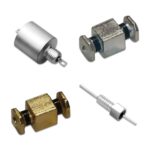onsemi announced the availability of the CEM102, a compact analog front-end (AFE) that enables electrochemical sensing with exceptional accuracy at very low currents. With its small form factor and industry-leading low power consumption, the CEM102 allows engineers to create versatile and compact solutions for industrial, environmental, and healthcare applications such as air and gas detection, […]
Analog IC Tips
SIM card level translator boasts ESD protection
HMI announced the launch of its HL5301WL01, a SIM card level translator with level shifting and IEC610004-2 electrostatic charge protection for SIM card ports. The HL5301WL01 integrates two unidirectional level shifters for the RST and CLK signals, a bidirectional level shifter for I/O, and ±8 kV electrostatic discharges (ESD) protection on all SIM card contacts. […]
Why use a switching regulator instead of a linear regulator for DC-to-DC conversion?
Most electronic systems rely on regulators to deliver stable direct current (DC) levels. This article explains how regulators operate and reviews the two primary types of regulators used for DC-to-DC conversion: switching and linear. It also compares their advantages and limitations, highlighting common use cases and applications for each. Regulating and refining DC voltage levels […]
ML algorithms, battery-efficient dashcam kit address parked vehicle monitoring
Aspinity has introduced a suite of new analogML™ algorithms tailored for parked-vehicle monitoring. These algorithms enable continuous vehicle monitoring without compromising battery life, addressing a critical challenge faced by the automotive industry. Additionally, the company has unveiled a dashcam-focused evaluation kit designed to enable precise detection and recording of security events over extended periods without […]
Analog and digital capabilities integrated into low-power transceiver
Arctic Semiconductor unveiled SilverWings. Representing a breakthrough in the industry, SilverWings is the first-ever 4×4 low-power transceiver offering multi-stage up and down conversion from digital to RF and RF to digital, empowering programmable and adaptable system designs. Leveraging Arctic’s renowned low-power architecture, SilverWings seamlessly integrates high-performance analog capabilities with high-bandwidth digital features, incorporating unique Digital-IF and High-IF […]
EMI filters protect circuits in space
Spectrum Control Inc. introduces Space Grade EMI filters that meet the stringent requirements of existing and emerging space technologies. Available in feed-thru, Pi, and L circuits in panel mount and surface mount packages (SMT), the EMI filters deliver high reliability and durability in satellite systems, spacecraft, antenna arrays, launch systems, orbital infrastructure, surveillance and tracking, […]
Analog switch series offers enhanced monitoring in 1.8 V systems
Nexperia introduced a new series of 4- and 8-channel analog switches designed to monitor and protect 1.8 V electronic systems. This series of multiplexers includes AEC-Q100-qualified variants intended for use in automotive applications as well as standard versions suitable for a broader range of consumer and industrial applications including sensor monitoring and diagnostics, enterprise computing, […]
Passive RFID finds unanticipated mass-market applications: part 2
Passive RFID tags have been widely adopted, and some applications show creative adaptation to unmet needs. While many uses for passive RFID tags were predicted and expected, innovators implemented some that were not obvious. This part will look at two of those applications. Clothing-store “mass” checkout One obvious application predicted for passive RFID labels was […]
Passive RFID finds unanticipated mass-market applications: part 1
Passive RFID tags have been widely adopted, and some applications show creative adaptation to unmet needs. It’s interesting to see how advances in technology often are adapted to applications that were not highlighted in their original “use case” scenarios and how clever people adapt or leverage new technologies in unscripted ways. A good example of […]
Next-gen op amps meet reliability requirements of AEC-Q100 Grade 1
NOVOSENSE Microelectronics has launched its new NSOPA series of general-purpose operational amplifiers. Engineered for automotive and industrial applications, these amplifiers can be widely used for signal conditioning of voltage, current, temperature, and other signals, OBC/DC-DC/PDU, traction inverters, BMS, thermal management, BCM, industrial automation, photovoltaic inverters, motor drivers, digital power supplies and charging stations. The inaugural […]











